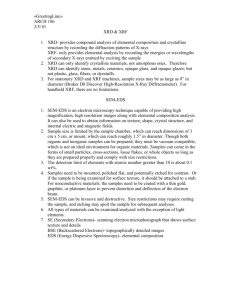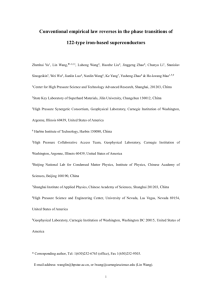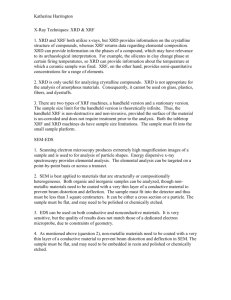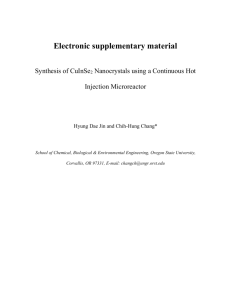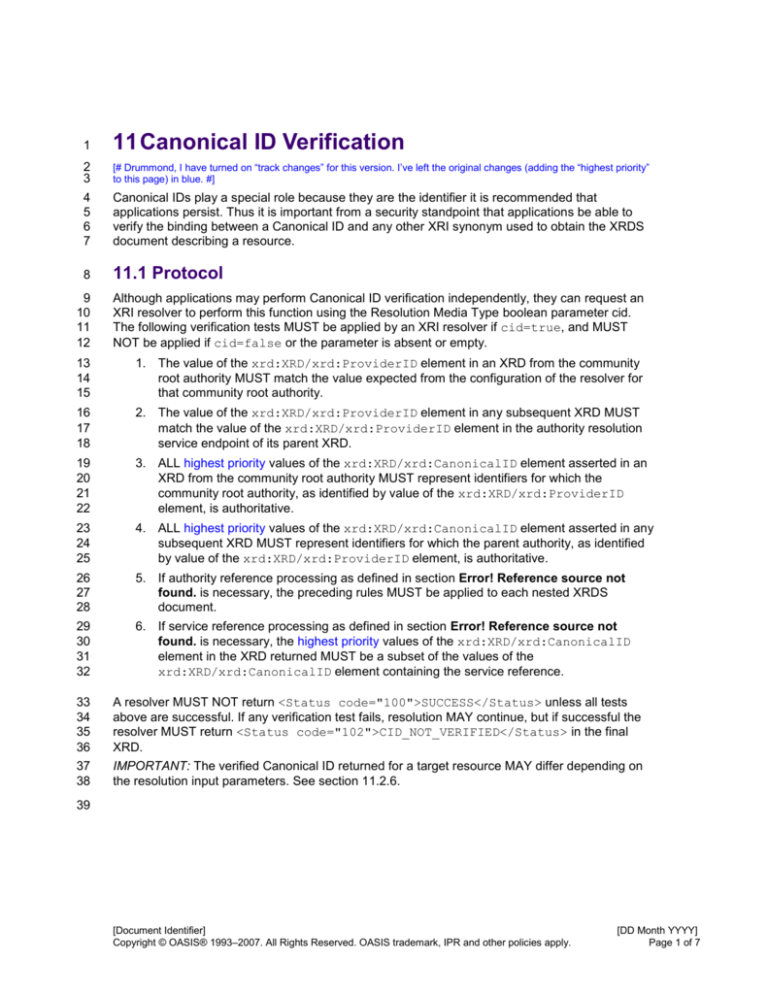
1
11 Canonical ID Verification
2
3
[# Drummond, I have turned on “track changes” for this version. I’ve left the original changes (adding the “highest priority”
to this page) in blue. #]
4
5
6
7
Canonical IDs play a special role because they are the identifier it is recommended that
applications persist. Thus it is important from a security standpoint that applications be able to
verify the binding between a Canonical ID and any other XRI synonym used to obtain the XRDS
document describing a resource.
8
11.1 Protocol
9
10
11
12
Although applications may perform Canonical ID verification independently, they can request an
XRI resolver to perform this function using the Resolution Media Type boolean parameter cid.
The following verification tests MUST be applied by an XRI resolver if cid=true, and MUST
NOT be applied if cid=false or the parameter is absent or empty.
13
14
15
1. The value of the xrd:XRD/xrd:ProviderID element in an XRD from the community
root authority MUST match the value expected from the configuration of the resolver for
that community root authority.
16
17
18
2. The value of the xrd:XRD/xrd:ProviderID element in any subsequent XRD MUST
match the value of the xrd:XRD/xrd:ProviderID element in the authority resolution
service endpoint of its parent XRD.
19
20
21
22
3. ALL highest priority values of the xrd:XRD/xrd:CanonicalID element asserted in an
XRD from the community root authority MUST represent identifiers for which the
community root authority, as identified by value of the xrd:XRD/xrd:ProviderID
element, is authoritative.
23
24
25
4. ALL highest priority values of the xrd:XRD/xrd:CanonicalID element asserted in any
subsequent XRD MUST represent identifiers for which the parent authority, as identified
by value of the xrd:XRD/xrd:ProviderID element, is authoritative.
26
27
28
5. If authority reference processing as defined in section Error! Reference source not
found. is necessary, the preceding rules MUST be applied to each nested XRDS
document.
29
30
31
32
6. If service reference processing as defined in section Error! Reference source not
found. is necessary, the highest priority values of the xrd:XRD/xrd:CanonicalID
element in the XRD returned MUST be a subset of the values of the
xrd:XRD/xrd:CanonicalID element containing the service reference.
33
34
35
36
A resolver MUST NOT return <Status code="100">SUCCESS</Status> unless all tests
above are successful. If any verification test fails, resolution MAY continue, but if successful the
resolver MUST return <Status code="102">CID_NOT_VERIFIED</Status> in the final
XRD.
37
38
IMPORTANT: The verified Canonical ID returned for a target resource MAY differ depending on
the resolution input parameters. See section 11.2.6.
39
[Document Identifier]
Copyright © OASIS® 1993–2007. All Rights Reserved. OASIS trademark, IPR and other policies apply.
[DD Month YYYY]
Page 1 of 7
40
11.2 Canonical ID Verification Graph Model
41
42
The Canonical ID Verification Graph Model establishes the foundation of identity required for the
Canonical ID verification of XRI synonyms.
43
11.2.1 Synonyms and absolute identity
44
45
46
47
48
49
XRI synonymity is one of the most important features of XRI Resolution. Identifier synonymity
cannot exist outside of an abstract model that formalizes the absolute identity of the object for
which two identifiers purport to be synonyms. In the Canonical ID Verification Graph Model, this
object is the authority node within the graph. Its absolute identity is defined by its canonical
identifier path, which is represented using the xrd:CanonicalID element of its XRD.
(Definitions of italicized terms such as canonical identifier path are given in section 11.2.7.)
50
51
52
53
54
Applications that support XRI synonyms may require a mechanism to safely verify that a given
XRI is truly synonymous with the object (the authority node) to which it purports synonymity.
Otherwise, the XRD returned for the purported synonym may contain illegitimate XRD metadata,
such as a spoofed endpoint for an authentication service. Canonical ID verification provides this
mechanism for safely binding the XRI synonym to the authority node’s canonical identifier path.
55
56
57
XRI Resolution does not preclude alternative models of XRI synonymity and/or object identity,
however the XRI Resolution Specification provides no mechanism for synonym verification under
such alternative models.
58
59
60
IMPORTANT: The graph model presented in this section describes relationships that validate
under Canonical ID verification. The model and its terminology are not intended for use outside of
this constraint.
61
11.2.2 Graph Notation and Conventions
62
63
64
When an XRI is resolved, the authority segment of the XRI represents a path through the
Canonical ID Verification Graph. Each XRI subsegment traverses an edge to the next child
authority node within the graph as shown in Figure 11-1.
[@]
*example
{!1}
[ @example ]
*west
{!1}
*east
{!2}
[ @example*west ]
[ @example*east ]
*john
{!1}
[ @example*west*john ]
[ {@!1!1!1} ]
65
66
*jane
{!1}
[ @example*east*jane ]
[ {@!1!2!1} ]
Figure 11-1. Canonical ID Verification Graph diagram.
[Document Identifier]
Copyright © OASIS® 1993–2007. All Rights Reserved. OASIS trademark, IPR and other policies apply.
[DD Month YYYY]
Page 2 of 7
67
11.2.3 Edges and local synonyms
68
69
70
71
The solid-line edges of the graph represent hierarchical parent-child relationships. (Under a
hierarchy, a given child node has at most a single parent.) Polyarchical parent-child relationships
(where a child node can have multiple parents) are denoted by dashed lines and are covered in
section 11.2.5.
72
73
74
75
76
77
78
The hierarchical edges are labeled with one or more local synonyms. Local synonyms establish
the naming relationship between a parent authority node (in its context as an Authority Resolution
Service) and the child authority nodes within its namespace. Under XRI Resolution, each local
synonym is addressed by the names of the subsegments in the authority segment of the XRI
providing the path through the graph. For example, resolving the XRI @example*east*jane will
result in traversing the edges containing the local synonyms *example, *east, and *jane, and
will produce the XRD for the node in the lower right corner of Figure 11-1.
79
80
81
In the graph diagram, the labeled local synonyms include one or more local canonical identifiers.
These are surrounded in the diagram with curly braces, as in {!1}, and they may be represented
using xrd:LocalID element(s) of the child node’s XRD.
82
83
84
The Resolver “queries” an Authority Resolution Service with the name of the local synonym in
order to obtain an XRD describing the given child. The local synonym may be returned in the
xrd:Query element of the resulting XRD.
85
11.2.4 Nodes
86
87
88
89
90
91
Nodes in the graph represent the “absolute identity” of the XRI authority, which, as stated above,
is a required property for verifying the synonymity of two XRIs. Under the constraints of the
Canonical ID Verification Graph Model, the local synonyms of each hierarchical edge must
contain at least one local canonical identifier. Thus authority nodes can be absolutely identified by
a canonical identifier path containing one local identifier subsegment for each edge up to the root.
The identifier {@!1!2!1} in Figure 11-1 is an example of such a canonical identifier path.
92
93
Note that nodes in the diagram may be labeled with square brackets containing XRI synonyms
that resolve to the given node.
94
11.2.5 Polyarchical parent-child relationships
95
96
Figure 11-2 shows both hierarchical and polyarchical parent-child relationships. Polyarchical
relationships are represented in the diagram with dashed-line edges.
[@]
[=]
*example
*jane.doe
{!1}
[ @example ]
*john
{!1}
*jane
[ @example*john ]
[ {@!1!1} ]
97
98
[ =jane.doe ]
[ @example*jane ]
[ {=!1} ]
Figure 11-2: Polyarchical parent-child relationship.
[Document Identifier]
Copyright © OASIS® 1993–2007. All Rights Reserved. OASIS trademark, IPR and other policies apply.
[DD Month YYYY]
Page 3 of 7
99
100
This diagram indicates that @example*jane and =jane.doe are both verifiable synonyms for the
authority node with canonical identifier path {=!1}.
101
102
103
104
Because the Canonical ID Verification Graph Model is constrained to those relationships that
validate under Canonical ID verification, any mechanism for establishing a polyarchical
relationship must be subject to this verification. The only mechanism for defining such verifiable
polyarchical parent-child relationships is the xrd:Ref element.
105
106
107
108
109
110
111
An xrd:Ref element forms a relationship from one authority node to another, however it is not a
parent-child relationship—its semantics are different. In essence, a Ref tells the Resolver, “if you
cannot find the service you’re looking for in my XRD, then replace my XRD by following this Ref,
and look there.” Whereas these “replacement” semantics are clearly not “parent-child semantics”
they effectively create a parent-child relationship between the parent of the node containing the
Ref and the Ref’s target. Figure 11-3 uses the dotted line to represent the Ref for the polyarchical
parent-child relationship “created” by the Ref in Figure 11-2.
112
113
114
115
116
Note that the relationship denoted by the dotted line (the Ref relationship) does not exist within
the Canonical ID Verification Graph. The Ref is shown in Figure 11-3 only to illustrate how the
polyarchical edge of Figure 11-2 was created. Instead, only parent-child relationships exist within
the graph model. (Recall that edges in the graph represent subsegment traversal, as explained in
section 11.2.3.)
[@]
[=]
*example
*jane.doe
[ @example ]
*john
*jane
(Ref)
[ @example*john ]
[ {@!1!1} ]
[ @example*jane ]
[ {@!1!2} ]
[ =jane.doe ]
[ @example*jane ]
[ {=!1} ]
117
118
Figure 11-3. Showing the Ref that creates the polyarchical edge of Figure 11-2.
119
120
121
122
Under CanonicalID verification, a canonical identifier path is not valid unless it satisfies the rules
presented in section 11.1. During Ref processing, the Resolver applies these verification rules to
any XRI constituting the target of a Ref. Therefore, XRI synonyms that contain polyarchical edges
as created by Refs are verifiable within the model.
123
[Document Identifier]
Copyright © OASIS® 1993–2007. All Rights Reserved. OASIS trademark, IPR and other policies apply.
[DD Month YYYY]
Page 4 of 7
124
11.2.6 Resolver input parameters
125
126
127
128
129
130
131
132
Under XRI resolution, the synonymity of two XRIs is defined only with respect to Resolver input
parameters. That is, two XRIs can be synonymous with respect to one set of input parameters
whereas they are not synonymous with respect to another set of input parameters. This is
because an xrd:Ref may be followed under one set of parameters—establishing a given
polyarchical parent-child relationship—whereas a different Ref (or no Ref at all) may be followed
under a different set of parameters (establishing a different relationship.) Section [# refer to the
section containing the “dereferencing rules” table #] describes these Ref “dereferencing” rules
under Canonical ID verification.
133
134
135
136
137
For example, under one set of Resolver input parameters, the XRI @example*jane may resolve
to the authority node with canonical identifier path {=!1} shown in Figure 11-2, whereas under
another set of input parameters it may resolve to the authority node with path {@!1!2} shown in
Figure 11-3. The difference in input parameters may be something as simple as a difference in
the requested service type (xrd_t).
138
11.2.7 Terminology and Constraints
139
140
This section describes terms used within the Canonical ID Verification Graph model. The
terminology is not intended for usage outside of this constrained model.
141
11.2.7.1 Local synonym
142
143
144
145
146
147
148
Local synonyms establish the naming relationship between a parent authority node (in its context
as an Authority Resolution Service) and the child authority nodes within its namespace. There
must be at least one local synonym for each parent-child relationship, and all local synonyms
must be unique across the given authority node’s children. When the Resolver queries an
Authority Resolution Service with a local synonym, the local synonym may be returned within the
xrd:Query element of the XRD. Local synonyms must be a single XRI subsegment. Local
canonical identifiers (section 11.2.7.2) are local synonyms.
149
11.2.7.2 Local canonical identifier
150
151
152
153
154
155
156
Local canonical identifiers are types of local synonyms that establish the canonical identity
relationship between a parent authority node (in its context as an Authority Resolution Service)
and the child authority nodes within its namespace. In the Canonical ID Verification Graph model,
there must be at least one local canonical identifier for each parent-child relationship, and all local
canonical identifiers must be unique across the given authority node’s children. When the
Resolver queries an Authority Resolution Service with any local synonym, the local canonical
identifiers may be returned using the xrd:LocalID elements.
157
11.2.7.3 Canonical identifier path
158
159
160
161
An authority node’s absolute identity is established by one or more canonical identifier paths.
When the Resolver queries an Authority Resolution Service with any local synonym, the
canonical identifier paths must be returned within the XRD’s highest priority xrd:CanonicalID
elements. A canonical identifier path is valid only under the rules defined in section 11.1.
162
163
164
165
166
167
An authority node may have multiple canonical identifier paths (multiple highest priority
xrd:CanonicalID elements) but, because the authority node has only one absolute identify,
each canonical identifier path must be a proper synonymous path, as described in section
11.2.7.5. Lower priority xrd:CanonicalID elements represent legacy canonical identifier paths
resulting from the merging of two XRI authorities. These are not validated under Canonical ID
verification and are thus not represented in the graph.
[Document Identifier]
Copyright © OASIS® 1993–2007. All Rights Reserved. OASIS trademark, IPR and other policies apply.
[DD Month YYYY]
Page 5 of 7
168
11.2.7.4 Synonymous paths
169
170
Paths that lead to the same to the same node. These paths may include hierarchical and/or
polyarchical edges.
171
11.2.7.5 Proper synonymous paths
172
173
Hierarchical paths with the same number of edges that traverse the same nodes in the same
order. These include hierarchical edges only.
[Document Identifier]
Copyright © OASIS® 1993–2007. All Rights Reserved. OASIS trademark, IPR and other policies apply.
[DD Month YYYY]
Page 6 of 7
174
175
[TODO: Provide example of XRDS documents with Canonical ID verification.]
176
177
[Document Identifier]
Copyright © OASIS® 1993–2007. All Rights Reserved. OASIS trademark, IPR and other policies apply.
[DD Month YYYY]
Page 7 of 7





